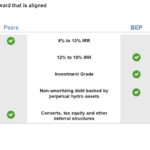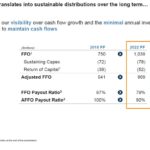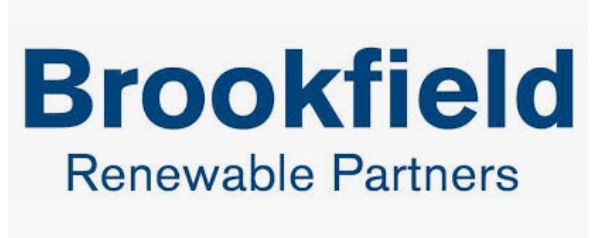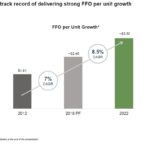Contents
Summary
- Like the other BAM entities I have analyzed, BEP adheres to BAM’s 5 core principles.
- BEP has recently initiated a capital recycling program similar to other BAM entities in which it rotates its investment from mature assets with lower IRR potential to new opportunities in which it can generate superior returns.
- BEP’s current annual distribution is 100% of AFFO but it has visibility over cash flow growth and the annual investment required to maintain cash flows is minimal.
- Servicing its growing distributions should not pose a problem and management has projected an improvement in BEP’s FFO and AFFO payout ratios over the next 5 years.
- I view BIP as an attractive long-term investment suitable for investors seeking a safe and steadily increasing stream of quarterly distributions.
- I have just acquired several hundred BIP units for the FFJ Portfolio.
Introduction
As a long time shareholder of Brookfield Asset Management (TSX: BAM-a) (NYSE: BAM), I continue to be impressed with the entire group of companies. It is only recently, however, that I have decided to increase my relatively insignificant exposure to the Limited Partnerships to slightly more meaningful levels.
On October 3rd I uploaded a post on Brookfield Property Partners L. P. (TSX: BPY-UN.TO) (NASDAQ: BPY). And on October 4th I uploaded a post on Brookfield Infrastructure Partners L.P. (TSX: BIP-UN.TO) (NYSE: BIP). In both cases, I ended up acquiring a few hundred units of each for the ‘side’ accounts within the FFJ Portfolio after conducting my review.
As I indicated in these recent posts, if your primary objective is to generate long-term capital gains then investing in BAM might be the preferred investment. Should dividend income be of greater importance to you than the potential for capital gains then investing in the higher dividend yielding Limited Partnerships might be your preferred choice.
Another advantage to investing directly in the Limited Partnerships is that you can target your investment to specific sectors. You may, for example, wish to have exposure to the renewable energy space but not the real estate space.
Based on my analysis of Brookfield Renewable Partners L.P. (TSX: BEP-UN.TO) (NYSE: BEP) which I conducted for this article, I have acquired a few hundred units for the ‘side’ accounts within the FFJ Portfolio.
Overview
BEP’s Corporate Profile provides a comprehensive overview of the company.
The world is in the early stages of a decades-long transformation from fossil fuels to renewable energy with this transformation being led by:
- Climate change;
- Government policy and subsidies;
- Historically low cost of capital;
- Increased demand from financial investors for long-duration renewable assets.
BEP’s analysis of the Renewable Energy space indicates that Solar and wind still account for less than 10% of global power supply (74% nuclear and fossil fuels, 17% hydro, and 9% solar and wind). BEP estimates that in excess of $11T of investment is estimated to be required to replace existing, non-renewable capacity globally.
As evidence of the global transformation to renewable energy, various businesses such as transportation and other industrial businesses are going through a significant restructuring. Traditional thermal fuel sources, which were powering electricity or transportation fleets, are being slowly replaced by electricity and carbon free electricity.
This transformation will take several decades. Given this trend, BEP is building a business that can leverage global growth and where it can acquire great businesses and great assets throughout the world at its target return levels.
The challenge for many industry participants is that just within the past 5 years, $1.5T has been invested in renewable energy (47% solar, 35% wind, 17% hydro, and 1% other) and over 1 million megawatts of new renewable capacity has been added to global grids (42% solar, 33% wind, 20% hydro, and 5% other). Many of these projects have been undertaken at high valuations and returns have been low (4 – 10% IRR for projects in operation and 7 – 12% IRR for projects in development).
This growth and low return environment has resulted in some industry participants using financial structures or other types of financial engineering to drive their target returns. This has resulted in some extreme financial challenges for some industry participants.
BEP, on the other hand, employs a very prudent capital structure. While it uses a very conservative financing approach, it is important not to gloss over the fact BEP drives value by being a smart buyer, by operating the assets well, and by ensuring it can drive margin through operations.
Unlike many other industry participants, BEP has had 12 – 15% IRR targets and these targets remain for future projects.
Being part of the BAM group of companies, BEP adheres to BAM’s 5 core principles:
- Acquire high quality assets;
- Invest on a value basis;
- Enhance value through operations;
- Contrarian investing;
- Large-scale and multifaceted.
It is imperative that investors in any one of the BAM companies realize that the manner in which the businesses operate entails the use of a capital recycling program. When an asset is acquired, the intent is not to hold the asset in perpetuity. The capital recycling program instills capital discipline to ensure that businesses are sold when returns are maximized and not when cash is needed.
Historically, BEP has not employed a capital recycling program but it recently has started to use it as part of its funding strategy; it has announced ~$0.315B of initiatives in the last 18 months. Under the program BEP will sell assets generating single-digit returns and will re-deploy the sale proceeds toward assets which will generate 12 – 15% returns.
Cash Flow
BEP monitors…
- visibility of growth;
- payout ratio;
- balance sheet strength;
- quality of cash flows;
…to assess the sustainability of its distributions.
BEP looks for opportunities in which it can use its operating expertise to drive cash flow growth since, from an overall perspective, it has set aggressive 6 – 11% FFO per unit growth. This growth is achieved through the following:
BEP has embedded inflation escalation in its plans and expects to generate 1 – 2% FFO per unit growth.
In Brazil and Colombia, BEP has 100% inflation pass-through of its revenues. In North America, there are some contracts that have inflation pass-through but on an overall basis, it is around 30%. In these 3 jurisdictions together, BEP expects to generate $10 – $15 million of annual FFO growth or ~$50 million over the next 5 years.
BEP expects to drive 2% – 4% FFO per unit growth through margin expansion over the long – term. This translates into $0.125B of FFO growth of which ~50% comes from cost-saving initiatives and ~50% from revenue growth.
BEP has an extensive and advanced global development pipeline of 1,300 megawatts. Over the last 5 – 6 years, it has completed 800 megawatts of development and it is targeting a thousand megawatts of development generating $0.125B of FFO.
The development pipeline includes:
- Wind farms in Europe, Colombia and Brazil;
- Small hydro facilities in Brazil;
- Distributed solar generation in North America and China.
 Source: BEP Investor Day Presentation – September 26 2018
Source: BEP Investor Day Presentation – September 26 2018
FFO Track Record
BEP has a proven track record of delivering strong FFO per unit growth with ~7% growth since 2012. It is confident its distribution growth is sustainable in that 80% of cash flows from hydro require minimal annual investment to maintain cash flows over the long-term. Only 5% of cash flows are return of capital thus putting less pressure on the company to reinvest capital to maintain its earning power over the long-term.
BEP, like BPY and BIP, is rated BBB+ by S&P which is the top tier of the lower medium category; this is investment grade and is the highest rating within BEP’s sector.
No material financings are required within the next 5 years and ~75% of the debt is non-recourse fixed rated financing structured on an investment grade basis with attractive loan covenants. Furthermore, more than 90% of BEP’s debt is financed on a fixed-rate basis. This means it is well insulated from the impact of rising rates. Furthermore, a 100 basis point increase would result in a less than 2% impact on FFO.
BEP also has significant access to liquidity with $1.7B available as at June 30th of which $1.4B is credit facilities and $0.3B is cash and marketable securities; BEP has credit facilities with 20 high quality lenders.
Since 2015, BEP has raised $3B primarily in the form of corporate debt and preferred shares. It also very recently issued its first corporate green bond in which it raised $0.3B.
As previously noted, BEP is also starting to use capital recycling as a more important part of its funding strategy.
In addition to its credit facilities and the capital recycling program, BEP has access to ~$5B of partner capital for investment purposes.
A common theme that runs through the BAM group of companies is the magnitude of the high quality cash flow generated. This provides investors with a greater degree of confidence that the distributions are sustainable and are highly likely to increase over time.
BEP generates its highly diversified cash flow both by technology (ie. solar, wind, and hydro) and by region. The nature of its cash flows are highly contracted with more than 90% contracted with an average contract term of 15 years; unlike some of BEP’s competitors it does not overly rely on subsidies.
One of the biggest differentiators is BEP’s perpetual asset base. It has the longest duration asset profile in the sector with greater than 75 years remaining in its asset life.
The backbone is BEP’s hydro business which makes up 80% of cash flows.
On the FX exposure front, BEP tightly manages this risk in that it fully hedges its developed market currencies. This means the correlation to a strengthening U.S. dollar is less than 50%. BEP has determined that a 10% increase in the U.S. dollar impacts its FFO by less than 5%.
 Source: BEP Investor Day Presentation – September 26 2018
Source: BEP Investor Day Presentation – September 26 2018
Growth Prospects
As recently as 5 years ago, BEP was predominantly a company operating in the Americas with a small presence in Latin America and Brazil; it had a much larger footprint in the US and Canada.
BEP understood the benefits of scale and knew it could drive significant cash flow growth from its operating capabilities. It, however, also recognized that if low rates persisted for a very long period of time and if the pace of growth were at levels BEP anticipated then too much capital would flow into this renewable energy market thus significantly driving down returns.
Given this, BEP decided to diversify its business and to create a global franchise thus enabling it to redeploy capital to various regions in which there was greater opportunity to generate superior returns.
Today, BEP’s business in South America is one of its largest at close to 5,000 megawatts. If you include BEP’s development pipeline in Europe, there is in excess of 5,000 megawatts.
The Latin America business has grown significantly and the business has continued to grow in North America but BEP acknowledges there is much work that needs to be done in Asia Pacific.
Earlier in the article I indicated that just within the past 5 years, $1.5T has been invested in renewable energy and over 1 million megawatts of new renewable capacity has been added to global grids. While there is 1 million megawatts of installed capacity, solar and wind accounts for less than 10% of the global power supply. It would appear there is ample growth opportunity over the next several decades in that these figures do not reflect any growth in demand nor the retirement of existing facilities or the electrification of transportation. This just simply represents replacing what is currently in place.
Historically, BEP has deployed $0.5B – $0.8B annually. There was no pattern to BEP’s growth and investments were made on the basis of where BEP thought there were opportunities to earn outsized returns. BEP also moved into different technologies where it felt it could generate the most value combined with the best investment opportunity.
BEP thinks it is realistic to see the continued deployment of $0.7B – $0.8B per year.
In the US, several states have come out with Requests for Proposal (RFPs) as they seek to increase their exposure to wind, solar, and hydro. BEP is of the opinion they are well set up to participate longer-term in the US.
BEP has had a presence in Brazil and Colombia and Chile is now a country in which it is prepared to invest; other BAM entities have experienced considerable success in that country. BEP currently has a small solar plant in Chile, and continues to see 3% – 4% demand growth.
Significant growth is anticipated in each of these countries over the next several years.
Europe continues to lead the world on renewable energy policy and the latest EU standards would require all generation in Europe to be renewable by 2050. This is a significant undertaking that EU states must meet to maintain their status in the Eurozone.
In China, BEP has a small presence but is setting itself up to be able to participate in the renewable electrification of the country and the drive to reduce pollution levels.
In India there is a huge effort to electrify the country. In the last 5 years there has been a build-out of transmission, infrastructure, and substation infrastructure to provide electricity to every village in the country. Within the last 5 years, 300 million people have been given access to electricity.
BEP has been largely a North American business and will likely remain so for the foreseeable future despite significant growth potential in Asia Pacific and Latin America. While some investors may wonder how BEP intends to generate 12% – 15% returns when the North American business only generates 6% – 8% returns, BEP is confident that its ability to price acquisitions properly coupled with its growth in emerging markets will enable it to achieve annual returns in the low teens.
Distributions
As noted in my recent BIP article, Adjusted Funds from Operations is the measurement of financial performance the BAM group of companies most heavily relies upon. The rationale for using this metric (generally equal to funds from operations (FFO) with adjustments made for recurring capital expenditures used to maintain the quality of the underlying assets) is that it is considered to be a more accurate measure of residual cash flow for unitholders; BAM has specifically stated on multiple occasions that this metric is the closest proxy to cash flow generated from the business on an annual basis.
BEP has forecast ~$2.40 in distributions for FY2018 and has projected distributions rising to ~$3.30 by FY2022. It has also projected an improvement in the FFO and AFFO Payout Ratios.
 Source: BEP Investor Day Presentation – September 26 2018
Source: BEP Investor Day Presentation – September 26 2018
The current AFFO Payout Ratio leaves little margin for error but I am not concerned. The predictability of the cash flows coupled with a capital recycling program should allow BEP to improve its payout ratios as projected. Furthermore, the BAM group of companies is well managed and I am confident BEP will continue to increase its distributions without any interruption.
The current USD $1.88 annual distribution is well covered by the current $3.00 FFO/Unit run-rate as of Q2 2018.
With quarterly distributions of USD $0.49 and each unit trading at USD $29.91, unit holders receive an attractive ~6.55% yield.
Final Thoughts
What appeals to me about the BAM group of companies is that its risk / reward profile is aligned. This means the BAM companies target the highest returns in their respective sector and they employ the most conservative financing structures. This way, they are not looking to extract returns from leverage but rather from operating and investing capabilities.
Far too often I have seen deferred financing structures that may benefit a company in the short-term but the significant deferred financing cost turns out to be less than beneficial over the long-term.
The BAM entities, however, use a conservative financing structure (ie. investment grade) and rely only on structures that are sustainable over the long-term. This gives me the comfort that these are appropriate long-term investments for a conservative investor such as me.
Based on my analysis of BEP, I have just acquired a few hundred units for the FFJ Portfolio and will receive the next quarterly distribution payable December 31st; unit holders as of the November 30th date of record will receive the next quarterly distribution.
I wish you much success on your journey to financial freedom.
Thanks for reading!
Note: I sincerely appreciate the time you took to read this article. Please send any feedback, corrections, or questions to charles@financialfreedomisajourney.com
Disclaimer: I have no knowledge of your individual circumstances and am not providing individualized advice or recommendations. I encourage you not to make any investment decision without conducting your own research and due diligence. You should also consult your financial advisor about your specific situation.
Disclosure: Long BEP, BIP, BPY, and BAM.
I wrote this article myself and it expresses my own opinions. I am not receiving compensation for it and have no business relationship with any company whose stock is mentioned in this article.



